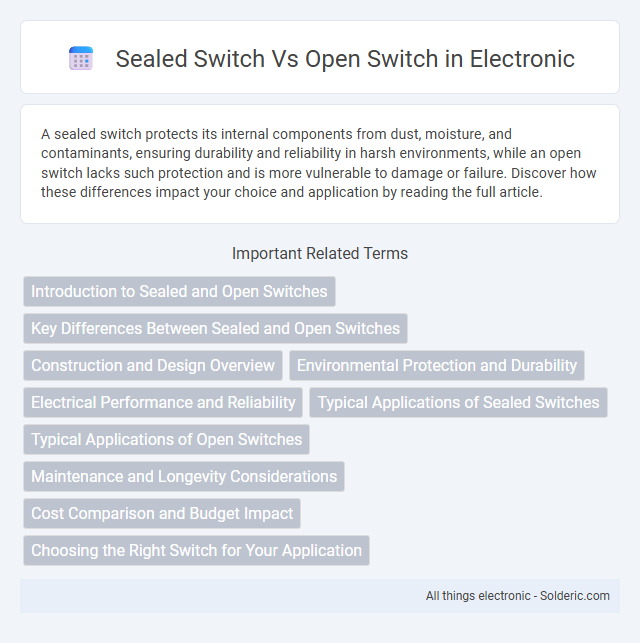A sealed switch protects its internal components from dust, moisture, and contaminants, ensuring durability and reliability in harsh environments, while an open switch lacks such protection and is more vulnerable to damage or failure. Discover how these differences impact your choice and application by reading the full article.
Comparison Table
| Feature | Sealed Switch | Open Switch |
|---|---|---|
| Protection | Enclosed, protects against dust, moisture, and contaminants | Exposed, vulnerable to environmental elements |
| Durability | High durability in harsh conditions | Lower durability in harsh environments |
| Maintenance | Low maintenance due to sealed design | Requires frequent cleaning and inspection |
| Sensitivity | Less sensitive to external interference | More prone to interference and damage |
| Application | Used in outdoor, industrial, and rugged environments | Common in controlled, indoor environments |
| Cost | Generally higher initial cost | Lower cost and easier replacement |
Introduction to Sealed and Open Switches
Sealed switches are designed with protective enclosures that prevent dust, moisture, and contaminants from entering, ensuring reliable performance in harsh environments. Open switches lack such protective barriers, exposing internal components to external elements, which may lead to corrosion or malfunction over time. These fundamental differences influence the selection of switches based on environmental requirements and application durability.
Key Differences Between Sealed and Open Switches
Sealed switches are enclosed in a protective casing, preventing dust, moisture, and contaminants from entering, which enhances durability and reliability in harsh environments. Open switches lack this enclosure, making them more susceptible to environmental damage but generally easier to inspect and maintain. The key difference lies in their construction and protection level, with sealed switches offering superior resistance to external elements compared to open switches.
Construction and Design Overview
A sealed switch features a protective enclosure that prevents contaminants like dust and moisture from entering, ensuring reliable operation in harsh environments. Its design incorporates rubber gaskets or resin encapsulation that maintain internal components' integrity. In contrast, an open switch has exposed contacts and terminals, making it more vulnerable to environmental factors but simpler in construction and easier to inspect or replace.
Environmental Protection and Durability
Sealed switches feature a protective enclosure that prevents ingress of dust, moisture, and contaminants, significantly enhancing environmental protection and extending their operational lifespan in harsh conditions. Open switches lack this barrier, making them more vulnerable to corrosion, debris accumulation, and mechanical failure when exposed to outdoor or industrial environments. The enhanced durability of sealed switches makes them ideal for applications requiring reliable performance under extreme weather or heavy-duty use.
Electrical Performance and Reliability
Sealed switches offer superior electrical performance by preventing dust, moisture, and contaminants from entering, which reduces contact resistance and enhances longevity. Open switches are more susceptible to oxidation and corrosion, leading to inconsistent conductivity and higher failure rates over time. Your choice of sealed switch ensures more reliable operation in harsh environments, making it ideal for critical and high-performance electrical applications.
Typical Applications of Sealed Switches
Sealed switches are commonly used in environments requiring protection against dust, moisture, and contaminants, such as automotive controls, industrial equipment, and outdoor lighting systems. These switches ensure reliable operation in harsh conditions by preventing ingress of harmful particles, enhancing durability and performance. Applications also include medical devices and consumer electronics where reliability and longevity are critical under variable environmental stresses.
Typical Applications of Open Switches
Open switches are commonly used in household lighting systems, allowing easy manual control to turn lights on or off. They are also prevalent in simple electrical circuits where user interaction is required for safety or operational purposes, such as in power strips and appliance controls. Industrial machinery often employs open switches for emergency stops and maintenance isolation due to their visible open or closed state.
Maintenance and Longevity Considerations
Sealed switches offer superior protection against dust, moisture, and contaminants, significantly reducing maintenance frequency and extending operational lifespan compared to open switches. Open switches require regular cleaning and inspection to prevent buildup and corrosion, which can accelerate wear and lead to premature failure. Your choice of switch type directly impacts long-term reliability and maintenance costs, with sealed switches providing a more durable solution for harsh environments.
Cost Comparison and Budget Impact
Sealed switches generally incur higher upfront costs compared to open switches due to robust housing and enhanced protection against dust and moisture, which can extend device lifespan and reduce maintenance expenses. Open switches, while cheaper initially, may lead to increased long-term costs from more frequent repairs and replacements caused by environmental exposure. Budget planning should weigh the initial investment of sealed switches against potential maintenance savings to determine the most cost-effective solution for specific operational conditions.
Choosing the Right Switch for Your Application
Choosing the right switch for your application depends on factors such as environmental exposure and electrical requirements. Sealed switches provide superior protection against dust, moisture, and contaminants, making them ideal for outdoor or harsh industrial settings. Open switches, while more cost-effective and easier to maintain, are best suited for controlled environments where exposure to elements is minimal.
sealed switch vs open switch Infographic

 solderic.com
solderic.com